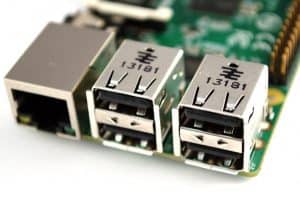Most orders for IN STOCK items placed by 12PM CST M-F ship SAME DAY. Orders for custom items and prints may take additional time to process.
Have you ever wanted to boot a
 Before we get down to it, let’s take just a second to understand why you might want to boot a
Before we get down to it, let’s take just a second to understand why you might want to boot a
* Note that you can not USB boot from the original
Now we will set the One Time Programmable (or OTP) bit on your
(Note for
Step 1: Install Raspbian on a Micro SD Card.The type of card and speed are mostly irrelevant as the card will not be needed after we configure the OTP memory.
Step 2: Boot the
sudo apt-get update sudo apt-get upgrade
Step 3: Now we can move on to programming the OTP memory to allow booting from USB. We need to make a change to the boot configuration file so that your Pi will boot up and be ready for the OTP changes.
echo program_usb_boot_mode=1 | sudo tee -a /boot/config.txt
Step 4: Issue the reboot command and let your
sudo reboot
Step 5: Verify that the OTP boot settings have been written. Open a new terminal window and enter the the following command:
vcgencmd otp_dump | grep 17:
If you entered everything correctly in step 3 you will see 17:302000a output on your screen. This confirms your
Remember to either remove this command from the /boot/config.txt or reload this Micro SD card with a fresh version of Raspbian, otherwise any Pi you place it into will have its OTP changed to USB boot.
Preparing a USB stick, hard drive, or other device to boot Raspbian is the same basic process you follow to prepare the Micro-SD card for booting. But in case this is your first time, we will walk you through quickly!
Step 1: Download the latest version of Raspbian from from the official Raspbian download page.
Step 2: Download Etcher from Balena Etcher and install it on your PC or Mac. Etcher writes images to SD Cards, and USB memory sticks. Once Etcher is installed, go ahead and launch it.
Step 3: Click select Image and select the Raspbian image you downloaded in Step 1.
Step 4: Select the drive you wish to flash (the USB stick your going to use to boot the
Step 5: Click flash and let Etcher do its thing. This could take anywhere from 30 seconds to a minute or two. Since Etcher is free, it will show you some
Step 6: When Etcher finishes and verifies the drive, eject it from your PC and plug it into any open port on your
Booting from USB takes about 10 seconds longer than booting from the Micro-SD Card. This is because the Pi will first look for an installed Micro-SD card, and then look for a USB boot device when one is not found. It just takes a few seconds for that process to happen. So don’t get nervous when your
That’s all you have to do to boot a
If you like our content maybe consider upgrading to Premium. You’ll get access to